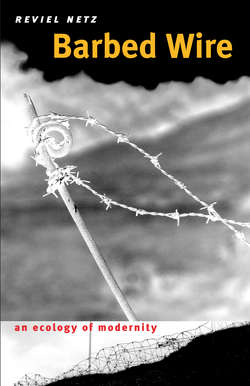Barbed Wire

Реклама. ООО «ЛитРес», ИНН: 7719571260.
Оглавление
Reviel Netz. Barbed Wire
CONTENTS
MAPS AND FIGURES
ACKNOWLEDGMENTS
INTRODUCTION
1 EXPANSION. The American West and the Invention of Barbed Wire
1. UNPACKING THE LOUISIANA PURCHASE
2. HOW TO FENCE A COW
3. HOW TO FENCE THE WORLD
2 CONFRONTATION. Barbed Wire on the Battlefield
1. CONQUEST BY IRON
2. CRISIS OF THE HORSE
3. PERFECTION OF THE OBSTACLE
4. THE OBSTACLE TRIUMPHANT
3 CONTAINMENT. Barbed Wire in the Concentration Camps
1. THE CONTROL OF NATIONS
2. ENEMY PEOPLE
3. TRACTORS TO UKRAINE
4. TRAINS TO AUSCHWITZ
EPILOGUE
NOTES. INTRODUCTION, pp. xi–xiv
1. EXPANSION, pp. 1–55
2. CONFRONTATION, pp. 56–127
3. CONTAINMENT, pp. 128–227
REFERENCES
INDEX
ABOUT THE AUTHOR
Отрывок из книги
BARBED WIRE
Acknowledgments
.....
It is here, finally, that barbed wire comes in. One of the visitors to the De Kalb fair, Joseph E Glidden, formed the following idea: instead of attaching Rose’s barbs to wood, they could be coiled around one of the strands in a double-stranded wire. The double-stranded structure, as well as the coil of the barb itself, would keep the barb in place. In short, unlike previous inventors, and emboldened by Rose’s idea, Glidden decided to make the barb fixed so as to resist the cow in its approach and to inflict real pain. Further, Glidden’s main technical idea—stranding two wires and a series of barbs between them—came from the experience of stranding wires together to form ropes, where the crucial fact was that machines already existed for the operation. No special new ingenuity was required: standard practices could be extended to achieve the mass production of barbed wire. And this is how barbed wire was born. In a sense, it was a natural idea, the confluence of all that went into the West: violence and the need to control space, iron, mass production. At any rate, a number of visitors to Rose’s exhibition at De Kalb went away with the idea of attaching barbs to iron fences instead of wooden boards. Glidden’s original patent was quickly joined, apparently independently, by five other barbed wire patents, and most began production almost immediately.33 Already in 1876, half the rights in one of the main patents were bought by Washburn and Moen, a Massachusetts-based iron and steel company, and in this way barbed wire reached the mainstream of manufacturing industry.34 It was an extension of existing technologies, and so, although it had been invented on the prairie, it was soon taken up by the mass producers of steel and iron.
Washburn and Moen knew what they were doing. Barbed wire was an instant success. In the spring of 1875, the first commercial leaflet produced by the fledgling Glidden company claimed that the fence had been tested already by more than a thousand farmers—hardly a hyperbole, as the statistics available from later in the decade would indicate. Some of the selling points Glidden made were especially interesting:
.....